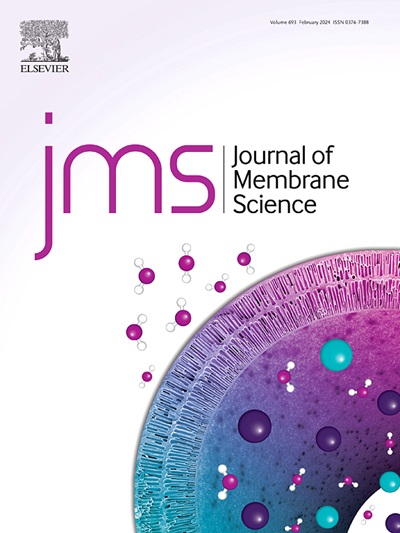Modeling fouling kinetics for experiments with transmission varying during filtration
IF 9
1区 工程技术
Q1 ENGINEERING, CHEMICAL
引用次数: 0
Abstract
Analyzing fouling mechanisms during membrane filtration using modeling approaches is often essential to identify ways to reduce the impact of fouling. However, in some cases, fouling modeling is made difficult because the progressive formation of a deposit modifies the transmission of species across the membrane (membrane selectivity) and therefore the flux of species accumulated on the membrane (fouling kinetics). A model is developed to describe the kinetics of fouling coupled with the change in selectivity induced by fouling. The originality of this model lies in the fact that it considers that the transmission of species changes as a result of the formation of deposits, where classic models consider transmission as constant. The model is compared with filtration experiments performed using a mixture of latex particles of different diameters on microfiltration membranes in the case where some of particles are smaller than the membrane pore size. It proves capable of describing both the fouling kinetics of and the time evolution of particle transmission. In addition, the model describes the variations frequently obtained when plotting the second derivative against the first derivative of filtration kinetics. Applying the model to different membranes (same announced pore size, different materials) reveals that variations in fouling behavior can be linked to differences in their internal porous structures, which influence their capacity for in depth accumulation prior to deposit formation.

过滤过程中透射率变化的污垢动力学模型
利用建模方法分析膜过滤过程中的污染机理对于确定减少污染影响的方法通常是必不可少的。然而,在某些情况下,污垢建模变得困难,因为沉积物的逐渐形成改变了物质在膜上的传输(膜选择性),因此改变了物质在膜上积累的通量(污染动力学)。建立了一个模型来描述污垢的动力学以及由污垢引起的选择性变化。该模型的独创性在于,它认为物种的传播随着沉积物的形成而改变,而经典模型认为传播是恒定的。将该模型与不同粒径乳胶颗粒混合在微滤膜上的过滤实验进行了比较,其中一些颗粒小于膜孔径。结果表明,该模型既能描述颗粒运移的污染动力学,又能描述颗粒运移的时间演化。此外,该模型描述了在绘制过滤动力学的二阶导数与一阶导数时经常得到的变化。将该模型应用于不同的膜(相同的宣布孔径,不同的材料)表明,污垢行为的变化可能与它们内部多孔结构的差异有关,这影响了它们在沉积形成之前的深度积累能力。
本文章由计算机程序翻译,如有差异,请以英文原文为准。
求助全文
约1分钟内获得全文
求助全文
来源期刊

Journal of Membrane Science
工程技术-高分子科学
CiteScore
17.10
自引率
17.90%
发文量
1031
审稿时长
2.5 months
期刊介绍:
The Journal of Membrane Science is a publication that focuses on membrane systems and is aimed at academic and industrial chemists, chemical engineers, materials scientists, and membranologists. It publishes original research and reviews on various aspects of membrane transport, membrane formation/structure, fouling, module/process design, and processes/applications. The journal primarily focuses on the structure, function, and performance of non-biological membranes but also includes papers that relate to biological membranes. The Journal of Membrane Science publishes Full Text Papers, State-of-the-Art Reviews, Letters to the Editor, and Perspectives.
 求助内容:
求助内容: 应助结果提醒方式:
应助结果提醒方式:


